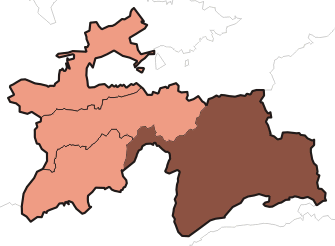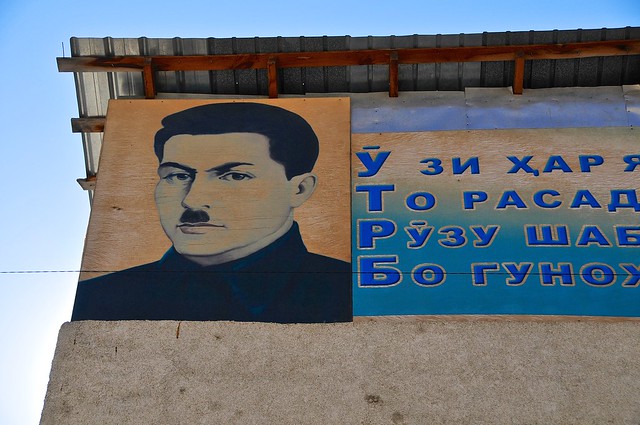From Merv to Serakhs
In the morning, after breakfast with my roommates, I set out to find a taxi to the border at Serakhs. I probably could have squeezed in a visit to the regional museum (which is supposed to be quite good), but share taxis typically leave in the morning and I wanted to make sure I would be able to make it all the way to Mashhad that day. The taxi lot is basically the parking lot in front of the train station, near the bus station, and I was able to find a driver without too much difficulty—we just had to wait for additional passengers.I'm something of a Coke addict, so while waiting I bought some samsas from the food vendors next to the station, and also picked up a bottle of Coke. This is a bit of a weird purchase, especially since I was low on manat, but I wasn't sure if Coke, as a western brand, would be available in long-isolated Iran (it turns out I shouldn't have worried, as both Coke and Pepsi have continued to exist since their introduction, likely before the revolution).
Although Mary doesn't look to be that far from Serakhs, don't discount how much farther things seem when the roads are horrible. Although even the main roads in Turkmenistan are surprisingly bad for a petrol country, the side roads are even worse, with lots of potholes that result in cars weaving from side to side to dodge them. Most of the ride to Serakhs was on exactly these kind of roads, and it took about three hours to get to Serakhs. We were dropped off a short distance from the immigration post, as there was a huge queue of trucks and cars lined up before the border.
Crossing the border
Leaving Turkmenistan was relatively painless, aside from again-mandatory border shuttle that we had to take, for the extortionate sum of $2, for a road that is about 1.5 kilometers long.On the Iranian side, things were considerably more complicated, and there a huge number of people in the waiting area. I'm not quite sure how things are supposed to work, but you give your passport to someone, then take a seat in a large waiting area. And then you wait. And wait. And then you'll be summoned, asked a few questions, and then told to sit and wait some more. One of the customs officers—an older, stern looking guy with a grey mustache—talked to himself in Farsi while he looked at my documents, then beamed at me and said "I love you!" before he resumed muttering to himself. I think it might have been the only thing he knew how to say in English, and the contrast between his otherwise grim demeanor and the warmth with which he said it was amusing. He then gestured that I should go sit down again.
I was eventually summoned into a commander's office, where I answered some questions and was stamped in shortly thereafter—it appears he was out or busy before then, and for some reason I needed to speak with him. In any event, it actually took significantly longer to process me than it did to process locals, and I suspect that if you entered at a busier border that is more accustomed to foreigners things would be substantially easier.
The Iranian side of the border compound is pretty big, with lots of various buildings and inspection points—much more organized and professional than the rather perfunctory border posts of Central Asian countries. One of the interesting things I noticed was a large steel water reservoir with spigots and on each side, as a kind of public water fountain, with one side for women and another for men. Once I made it outside the border area, I stopped by the gate and fired up my netbook. I had downloaded an old version of the Lonely Planet Iran (this was the first country for which I didn't have a hard copy of LP), and hoped to find some useful information on how to get to Mashhad, but it honestly wasn't of much help.
Arriving overland usually makes the transition between countries and places much smoother, but in all honestly the difference between Turkmenistan and Iran was even greater than the difference between China and Kyrgyzstan (going between the CIS 'stans is relatively easy in comparison)—or perhaps it is more accurate to say that the differences made it more challenging. In Iran everything looks different. There is no Soviet-style architecture but a lot of narrow, low-rise concrete storefronts with glass windows running the width of them; no Cyrillic, and little Latin, but lots of Arabic script; the people look different, with lots of facial hair for men and hijabs for women; and decent infrastructure with French cars.
I was to quickly learn that Iranian drivers are crazy, but this wasn't immediately apparent as Serakhs seemed strangely dead when I headed into the city, and I wasn't sure where I should change money. Of course, the fact that most signs were in Arabic script didn't help matters. I wandered around the city for a while, hoping to find a bus station (or a friendly local to offer to help), but no such luck (this is likely because, as I later learned, I pass as Iranian—if you look white or western you'll have no problem attracting copious attention and inquiries), so I walked back towards the border point. Although I hadn't seen an share taxis nearby, I figured that they must congregate somewhere nearby. It turns out that I was correct, as there is a gas station along the main road to Mashhad, across from the park that separates the border point from the city, and cars to Mashhad congregate at the roadside there.
As in Turkmenistan and Uzbekistan, Iran subsidizes gasoline. Not to the extreme extent that Turkmenistan did, but it is still very cheap, which has a salutary effect on transportation prices (as did the massive devaluation of the rial that occurred in early 2012—it dropped from about 1,000 rial to the US dollar to about 3,000 to the USD, largely as a result of increased economic sanctions). I had little idea how much it should cost to get to Mashhad, but I was able to get there for the paltry sum of $3. Again, it helped that the driver wasn't a professional driver but just a private individual going to Mashhad and looking to defray costs, and it may have helped that I had to pay in dollars and they seemed unsure of what exchange rate to apply.



